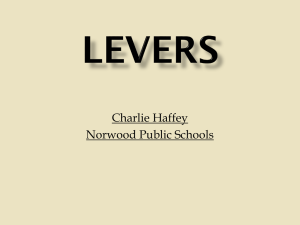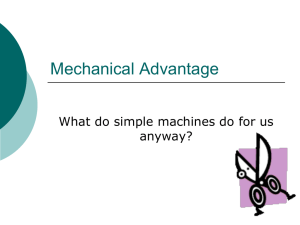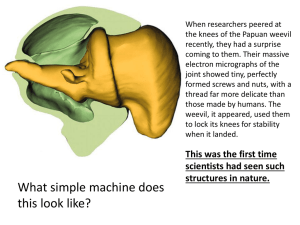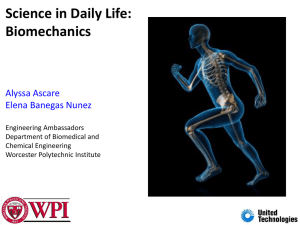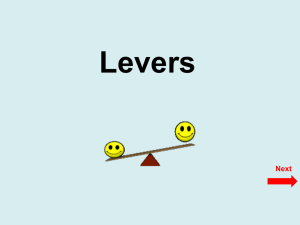Archimedes` Law of Lever
advertisement
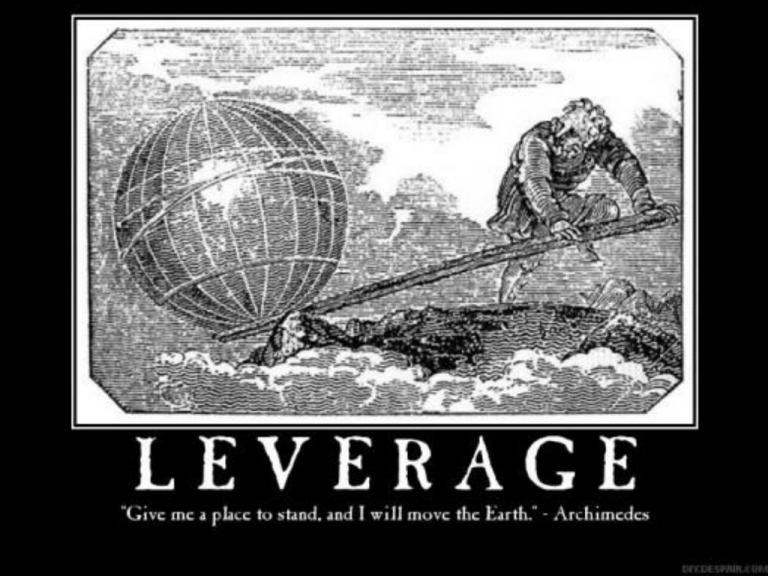
Group Members: Xinyi Liu xql5181 Jizhao Cai jvc5696 Tan Wang txw5149 What Is Lever A lever is a machine consisting of a beam or rigid rod pivoted at a fixed hinge or fulcrum. It is one of the six simple machines identified by Renaissance scientists. A lever amplifies an input force to provide a greater output force, which is said to provide leverage. The ratio of the output force to the input force is the ideal mechanical advantages of the lever. The law of Lever Assuming the lever does not dissipate or store energy, the power into the lever must equal the power out of the lever. As the lever rotates around the fulcrum, points farther from this pivot move faster than points closer to the pivot. Therefore a force applied to a point farther from the pivot must be less than the force located at a point closer in, because power is the product of force and velocity. If a and b are distances from the fulcrum to points A and B and let the force FA applied to A is the input and the force FB applied at B is the output, the ratio of the velocities of points A and B is given by a/b, so we have the ratio of the output force to the input force, or mechanical advantage, is given by MA = FB/FA = a/b This is the law of the lever, which was proven by Archimedes using geometric reasoning. Clases ClassesofofLever Lever Class 1: Fulcrum in the middle: the effort is applied on one side of the fulcrum and the resistance on the other side, for example, a crowbar or a pair of scissors. Class 2: Resistance in the middle: the effort is applied on one side of the resistance and the fulcrum is located on the other side, for example, a wheelbarrow, a bottle opener or the brake pedal of a car. Mechanical advantage is greater than 1. Class 3: Effort in the middle: the resistance is on one side of the effort and the fulcrum is located on the other side, for example, a pair of tweezers or the human mandible. Mechanical advantage is less than 1. Archimedes Clases of Lever The earliest remaining writings regarding levers date from the 3rd century BC and were provided by Archimedes. "Give me a place to stand, and I shall move the Earth with it“ is a remark of Archimedes who formally stated the correct mathematical principle of levers. Archimedes was born c. 287 BC in the seaport city of Syracuse, Sicily, at that time a selfgoverning colony in Magna Graecia, located along the coast of Southern Italy. He died c. 212 BC during the Second Punic War. The last words attributed to Archimedes are "Do not disturb my circles", a reference to the circles in the mathematical drawing that he was supposedly studying when disturbed by the Roman soldier. Lever The Clases law of of Lever Before Archimedes “Mechanica” is a work believed to have been written by the Peripatetic School, which is the name given to the followers of Aristotle. It was probably written in the years between the death of Aristotle in 322 BC and the birth of Archimedes c. 287 BC. The “kinetic” argument for the Law of the Lever given in the passage comes close to the idea of energy as the product of force and distance, to the concept of the conservation of energy, and to the principle of virtual velocities. As such, it is a more seminal argument than Archimedes’ “static” one, which does not provide much insight as to why the law is valid. But Archimedes used geometric reasoning to prove the law of lever. \ Clases of Lever Effects of law of Lever A lever is a simple machine that allows people to gain a mechanical advantage in moving an object or in applying a force to an object. It is considered a "pure" simple machine because friction is not a factor to overcome, as in other simple machines. There are many things in our daily life use the law of law of lever. Such as Scissors, a wheelbarrow, a bottle opener, a pair of tweezers or the brake pedal of a car. The common uses of the law of lever make people’s life more convenient. References Clases of Lever Davidovits, Paul (2008). "Chapter 1". Physics in Biology and Medicine, Third edition. Academic Press. p. 10. Uicker, John; Pennock, Gordon; Shigley, Joseph (2010). Theory of Machines and Mechanisms (4th ed.). Oxford University Press, USA. Usher, A. P. (1929). A History of Mechanical Inventions. Harvard University Press (reprinted by Dover Publications 1988). A. P. Usher, 1929, A History of Mechanical Inventions, Harvard University Press, (reprinted by Dover Publications 1968).

